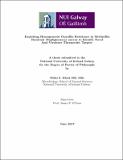| dc.contributor.advisor | O'Gara, James | |
| dc.contributor.author | Black, Nikki | |
| dc.date.accessioned | 2017-06-12T07:27:14Z | |
| dc.date.available | 2017-06-12T07:27:14Z | |
| dc.date.issued | 2017-06-08 | |
| dc.identifier.uri | http://hdl.handle.net/10379/6563 | |
| dc.description.abstract | The number of antibiotic-resistant bacterial infections have continued to increase in recent
years and have drawn global concern to the potential future of living in a post-antibiotic
era. These infections are of major concern being a signi cant cause of morbidity and
mortality worldwide, including in developed countries. Methicillin-resistant S. aureus,
can have a mortality rate more than double that of methicillin-sensitive S. aureus
strains, and treatment can be more than twice as expensive. With an ever decreasing
list of antibiotic therapeutic options at our disposal, we must invest not only into the
development of novel antibiotic compounds but alternative non-bactericidal alternative
therapeutic options.
Homogeneous oxacillin resistance selection has the potential to be used as an
anti-virulence therapeutic, as well as a use in identifying novel targets in pathways
associated with attenuation of virulence. Comparative bacterial genomics of heterogeneo-
us (HeR) oxacillin resistant MRSA and their isogenic homogeneous(HoR) oxacillin
derivatives identi edmultiple novel mutations in genetic loci associated with the c-di-AMP
and stringent response nucleotide signaling pathways. In homogeneous oxacillin resistant
isolates derived from a one step plating method with oxacillin 100 g/ml and USA300
HoR isolates derived from a continuous chemostat culture, novel gene ampli cation
events were reported associated in some cases with increased copy number of the
SCCmec. Mutation of the gene gdpP (encoding the c-di-AMP phosphodiesterase)
and hpt (encoding hypoxanthine-guanine phosphoribosyltransferase) were identi ed
as contributing to homogeneous oxacillin resistance. gdpP-dependent homogeneous
oxacillin resistance was observed to have phenotypic changes in cytotoxicity, glycosylation
of wall teichoic acid, and cell wall biosynthesis. These observations promote the c-di-AMP
signaling pathway as a potential novel anti-virulence target. In contrast the hpt-dependent
homogeneous oxacillin resistant phenotype was associated with a neutral e ect on
cytotoxicity and limited impact on bio lm production and autolysis. Homogeneous
oxacillin resistance selection can have pleiotropic e ffects on the physiology of S. aureus
and is dependent on the associated chromosomal modi fications. Through developing
our understanding of these pathways we can identify novel targets for anti-virulence
therapeutic strategies. | en_IE |
| dc.rights | Attribution-NonCommercial-NoDerivs 3.0 Ireland | |
| dc.rights.uri | https://creativecommons.org/licenses/by-nc-nd/3.0/ie/ | |
| dc.subject | Antibiotic resistance | en_IE |
| dc.subject | c-di-AMP | en_IE |
| dc.subject | MRSA | en_IE |
| dc.subject | Hypoxanthine-guanine phosphoribosyltransferase | en_IE |
| dc.subject | Anti-virulence | en_IE |
| dc.subject | Phosphoribosyltransferase | en_IE |
| dc.subject | Microbiology | en_IE |
| dc.subject | Hypoxanthine-guanine | en_IE |
| dc.title | Exploiting homogeneous oxacillin resistance in methicillin resistant staphylococcus aureus to Identify novel anti-virulence therapeutic targets | en_IE |
| dc.type | Thesis | en_IE |
| dc.contributor.funder | Health Research Board Ireland | en_IE |
| dc.local.note | A comparative bacterial genomic study to identify mutations associated with high-level oxacillin resistance in methicillin-resistant Staphylococcus aureus. | en_IE |
| dc.local.final | Yes | en_IE |
| nui.item.downloads | 136 | |


